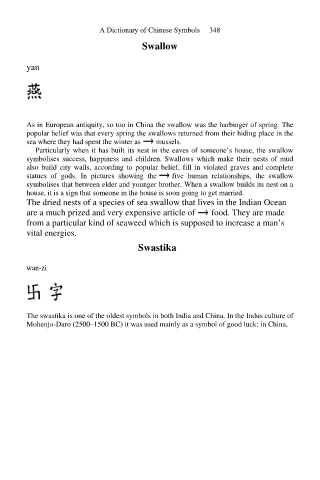Page 355 - A Dictionary of Chinese Symbols BIG Book
P. 355
A Dictionary of Chinese Symbols 348
Swallow
yan
As in European antiquity, so too in China the swallow was the harbinger of spring. The
popular belief was that every spring the swallows returned from their hiding place in the
sea where they had spent the winter as mussels.
Particularly when it has built its nest in the eaves of someone’s house, the swallow
symbolises success, happiness and children. Swallows which make their nests of mud
also build city walls, according to popular belief, fill in violated graves and complete
statues of gods. In pictures showing the five human relationships, the swallow
symbolises that between elder and younger brother. When a swallow builds its nest on a
house, it is a sign that someone in the house is soon going to get married.
The dried nests of a species of sea swallow that lives in the Indian Ocean
are a much prized and very expensive article of food. They are made
from a particular kind of seaweed which is supposed to increase a man’s
vital energies.
Swastika Swastika
wan-zi
The swastika is one of the oldest symbols in both India and China. In the Indus culture of
Mohenjo-Daro (2500–1500 BC) it was used mainly as a symbol of good luck; in China,

